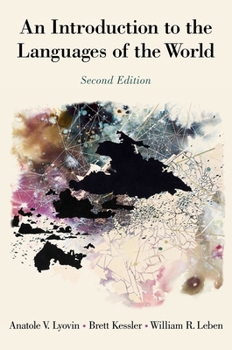An Introduction to the Languages of the World
Select Format
Select Condition 
Book Overview
Unique in scope, An Introduction to the Languages of the World introduces linguistics students to the variety of world's languages. Students will gain familiarity with concepts such as sound change, lexical borrowing, diglossia, and language diffusion, and the rich variety of linguistic structure in word order, morphological types, grammatical relations, gender, inflection, and derivation. It offers the opportunity to explore structures of varying...
Format:Paperback
Language:English
ISBN:0195149882
ISBN13:9780195149883
Release Date:January 2017
Publisher:Oxford University Press, USA
Length:544 Pages
Weight:1.75 lbs.
Dimensions:1.2" x 6.1" x 9.1"
Customer Reviews
2 ratings
Broad and occasionally deep
Published by Thriftbooks.com User , 13 years ago
The purpose of this book is to teach languages; some linguistics is taught in the process, but the emphasis is on languages. The main body of the book consists of six chapters, one for each continent (Oceania is grouped with Australia), and one for pidgin languages. The surrounding material consists of chapters on classification of languages and writing systems, and a set of language maps. Each chapter in the main body starts with a summary of the languages found in the region concerned, followed by "sketches" of two languages from the region; exercises introducing a few more languages and selected literature references conclude the chapter. This approach gives quite a balanced view of the languages of the world. The languages featured are: Europe: Russian and Finnish (with exercises about Turkish and Sanskrit); Asia: Mandarin Chinese and Classical Tibetan (+ Hmong and Japanese); Africa: Modern Literary Arabic and Swahili (+ !Xu (Khoisan)); Oceania: Hawaiian and Dyirbal (+ Tagalog, Fijian and Buang (Papuan)); Americas: Yup'ik (Eskimo) and Quechua (+ Hixkaryana, Aztec, and Huave); Pidgin and Creole: Tok Pisin (+ Hawaiian Creole English. Each "sketch", which is actually a description of reasonable depth, covers the background, phonetics, morphology, and syntax of the language, in about twenty pages. This knowledge is then applied to analyse a small (about fifteen sentences) text; the analysis consists of a literal morpheme-by-morpheme translation, explanatory notes and a translation to normal English. These sketches are of high quality; seriously working your way through such a "sketch" gives one a good grasp of the language and may well allow one to decipher simple texts in it, using a dictionary. The treatment of the languages in the exercises is of course much more restricted. The chapter in pidgins and creoles has this same structure, and Tok Pisin (Talk Pidgin) gets the same treatment as, for example, Finnish or Quechua. It is remarkable how much Tok Pisin looks like a normal language under this treatment, even though it is evident that the English original is never far away: "Dispela man i kam asde em i papa bilong me" = This-fellow man he come yesterday him he father belong me = This man who came yesterday is my father. In summary this book gives the student/reader some knowledge of a very wide range of languages and their features, supplemented by more in-depth knowledge of a dozen or so specific languages; a good combination it seems to me. Having finished the book I came away with the intuitive impression that actually all languages are the same. For example, some languages have prepositions, some have postpositions, and others have case endings, and so on, but even these differences repeat themselves so often that they become next to meaningless.
Not a book to read, but a useful reference
Published by Thriftbooks.com User , 20 years ago
This book introduces the languages of the world by continent in eight chapters. For every language genetic affiliation and the number of speakers is given. There is a striking imbalance in the treatment of the languages of the Americas, and those of other continents. In particular, the languages of Africa and Southeast Asia are only described very sketchily. At the end of each chapter (continent) an in-depth discussion of two selected languages is provided.Although the book is obviously designed as a textbook, it can only be recommended only as a reference, or as one among many textbooks for a specific course, because the style is too monotonous. It is also not a book to read through unless you are a language freak.Since the book came out in 1997, it is not up-to-date any more in every area. Still, the author's cautious and balanced approach makes it a reliable reference.





